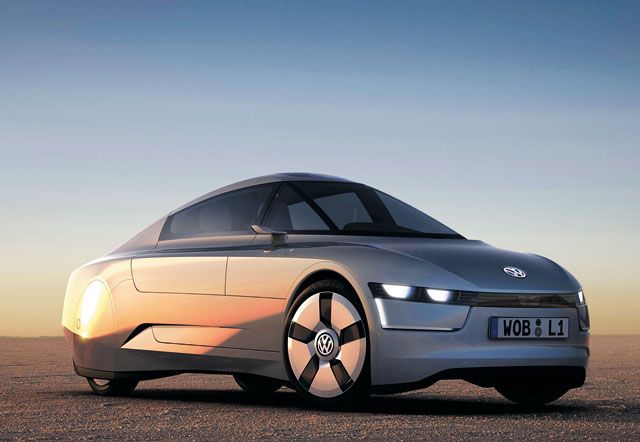If you think all hybrid cars are mirthless, BMW would like you to meet its Vision: a stealth submarine of a car, lower than a boxing foul, all folded geometry and LED tracer lights. The signature BMW grille glows blue like a reactor cooling pond. The transparent doors open like dragonfly wings.
The all-wheel-drive Vision sport coupé is the Usain Bolt of hybrid cars: zero to 60 mph in under 4.8 seconds, top speed of 249km/h, 356bhp and handling and braking comparable to the company's brain-melting M3 coupé. Fuel economy: 120km per gallon. And you can plug it in.
The Vision is one of several so-called electro-diesels at the Frankfurt Motor Show that put a typically European spin on Japan's signature eco-tech of hybrids. By combining electric motors and batteries with the huge torque and efficiency of direct-injection turbo-diesels, the European automakers are breeding a species of car that delivers V-8 performance with the fuel economy of mopeds.
Behind the menacing grille of the Vision, there's a small, 1.5-litre, 163-horsepower three-cylinder turbo-diesel engine and a big electric traction motor; arrayed like a capital "I" running down the spine of the car are rows of lithium-polymer batteries. At the rear axle is another electric motor, which gives the car essentially all-wheel drive. Together these components produce a whopping 590 pound-feet of torque, considerably more than your average Lamborghini.The Vision, which uses batteries developed for Apache attack helicopters, is only an experimental vehicle for now. But "all the components are very realistic," says Philip Koehn, BMW's director of concept vehicle development. The batteries, the diesel components and electric motors are "off the shelf", he adds. Too flashy for you? At the other end of the performance spectrum is Volkswagen's L1 concept, a hyperlight, tandem-seat oil-burner, like a bobsled for the road.
Getting its world premiere in Frankfurt, the L1 is powered by a small, two-cylinder turbocharged direct-injection (TDI) diesel engine and a small electric motor.
The L1's marquee number: 273km per gallon, or about four times that of a Honda Insight hybrid. If it comes to market as planned in 2013, the VW L1 could claim the title of most fuel-efficient passenger car on the road.
It would also be one of the cleanest. On a carbon-gram-per-mile basis - that's the emissions metric that Europeans are most concerned with - electro-diesels can outperform the thriftiest gas hybrids on the planet.
In the case of the Vision, BMW says the car produces 99 grams of carbon per kilometre on its own; plug it in and that number drops to 50g/km.
Depending on what you call a hybrid, electro-diesels already have arrived. Audi sells two diesel cars equipped with small starter/generators and battery packs to give them stop/start capability (the engine shuts down when the car is put in neutral). But many people think of hybrids as cars with powerful electric motors that can move at low speed on battery power alone. The first such diesel car to come to market will be the Peugeot 3008 HYbrid4. Arriving in the US in spring 2011, this mid-size sport-utility vehicle is expected to get about 100 km per gallon and produce 99 g/km of carbon. A HYbrid4 version of the company's RCZ sports coupé is all but certain.
For years European automakers, who are the acknowledged masters of turbo-diesel technology, quietly have stewed as Asian companies reaped the green-image benefits of hybrid technology.
On a cost and emissions basis, German automakers claim turbo-diesel engines are more efficient. One reason is that diesel fuel itself has a higher energy content than petrol.
Still, hybrids offer some advantages. They recover kinetic energy as they brake or coast and use it to charge the batteries. They also save fuel by shutting down the internal-combustion engine when the vehicle comes to a stop. And they can move on electric power alone at low speeds, where internal combustion engines are less efficient. So why not combine the best of both? Cost, mostly.
"Normal turbo-diesels are already so powerful and efficient [on the order of 30 per cent more efficient than gasoline engines] that it was a challenge to improve on that and very expensive," says Volker Mornhinweg, the head of Mercedes-Benz's high-performance AMG division.
Then there's the inherent incompatibility of diesels and electric power sources. Both produce torque at low revolutions per minute. Petrol engines, in contrast, product most of their torque at higher speeds. So in a petrol hybrid, the engine torque ramps up just as the electric motor torque is falling off. That creates a seamless yin and yang, a complementary blending of mechanical forces that's missing in the diesel-electric union.
But thanks to some advances in the field, including software necessary to smoothly integrate diesel and electric power, the hybrid diesel equation has become more promising. It's still difficult. And expensive. But the eye-popping petrol mileage of this marriage is what keeps the Europeans pushing.
"It's better in terms of total fuel efficiency to make a diesel hybrid," says Christophe Chateau, technology spokesman for French automaking giant Peugeot. It also can be better marketing. Chateau points out that because Peugeot's hybrid system situates electric motors on the rear axle (like some Lexus gas hybrids) the cars are in effect all-wheel drive. Buyers who might not pay the extra price for an electro-diesel might be willing to pay a premium for AWD.
"We will get much more sales for this big amount," Chateau says. Peugeot and other manufacturers see battery-electric powertrains as the most likely technology for small urban cars of the future. Because of the cost factor, electro-turbo-diesel probably will remain an up-market option. "We will not find this combination in too low-cost cars," BMW's Koehn says.
But there's an unknown out there: the increasing cost to rein in diesel emissions. In Europe, diesel cars command about 60 per cent of the market; Europe, however, has less-strict rules regarding diesel emissions of particulates and nitrous oxides.












